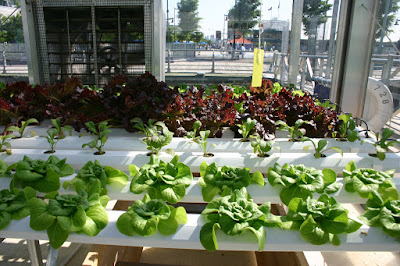Growing with Aquaponics allows you a great degree of flexibility with layouts, and crop volumes, and there are several systems that you can use to maximise the harvest from your own growing space.
Here I list the different systems that are available, and I try to give a little insight on each. You may find that one method is best for you, or you may want to incorporate some of each, whichever, they all work.
The types of aquaponic systems currently in use are:-
- Media Beds
- Raft
- Nutrient Film Technique (N.F.T)
Without getting all technical, the principle is the same for each system. Water is pumped from the fish tank, flows into the planted area, and returns to the fish tank, cleaned by the plants which use the fish waste as nutrients to grow. The simple diagram below explains this perfectly I feel.
An alternative to this is to incorporate a siphon into the grow bed, which means the pump can run continuously. Once the siphon is activated by the high water level, it will drain quickly bringing a rush of air to the plant roots. A bit of technical skill is required here to install a siphon and get it working, but once it's running you have nothing else to do except to keep it free from debris, meaning you have no need for a timer.
I digress....
Let me explain the different systems to you.
Media Beds.
Media beds, in my opinion, are the easiest to set up. Take a water-tight container, run an inlet pipe to just below the rim, and make hole in the bottom for the outflow pipe, fill with growing media, and plant it up with bare root plants. It is that simple. The photo below shows my media beds when I initially set them up.
Why would you want to use a media bed?
The reason that I like media beds is that the bed itself, and not just the plants, becomes a large mechanical, and biological, filter. Debris gets trapped by the media, preventing it returning to the fish tank, and good bacteria grows on the media itself, and consumes excess waste, thereby keeping the water really clean for the fish.
The media also acts as an anchor to keep larger plants firmly rooted in the growbed, which is especially useful if you happen to live in a windy area, and have your system outside as I do.
Media beds are great for debutants, as there are not many components, however, it is not necessarily great for maximising plant growth. This system tends to be used more by hobbyists than for large scale growing.
Raft / Deep Water Culture ( D.W.C )
Picture this as an empty media bed, filled with water and a floating raft on top.
The raft is typically a large sheet of styrofoam, around one inch thick, with holes cut into it of around two inches, at evenly spaced intervals all over the sheet. Seedlings are planted into net pots, filled with expanded clay or coir, and these fit into the holes.
The photo below was my first attempt, although I need to cut more holes, and larger, but you get the general idea. ( I need to use slightly thinner styrofoam too! )
You can see that the raft is floating on the surface of the inner container.
As opposed to media beds, in order to avoid water quality problems, additional filters would be required in the system, to separate the solid wastes and to stop them returning to the fish tank.
The raft system allows for increased, or mass, production and really offers a solution for food sustainability, and many different crops can be grown in this system.
Aquaponic raft systems are fairly straightforward to set up, and not too expensive. Additionally, once a harvest has been done, the styrofoam boards can be re-used for the next crop.
 |
| By Bryghtknyght (Own work) [CC BY 3.0 (http://creativecommons.org/licenses/by/3.0)], via Wikimedia Commons |
Nutrient Film Technique (N.F.T)
Nutrient Film Technique is a method used in hydroponics, that has been carried over to aquaponics. Plants are grown in channels such as rainwater pipes, or gutters. As in the raft method, holes are cut into the pipes and the plants grown in net pots containing a small amount of substrate. The water flow is continuous and thin, allowing for plenty of oxygen to flow around the plant roots.
This system is really only beneficial for growing shallow-rooted crops such as lettuce and greens, and attention should be paid to clogging in the pipes. The best size pipes to use are four inches in diameter, as this reduces clogging risk, any smaller and maintenance time will be increased.
 |
| By Ryan Somma (Leafy Greenhouse) [CC BY-SA 2.0 (http://creativecommons.org/licenses/by-sa/2.0)], via Wikimedia Commons |
The Nutrient Film Technique does allow for growing a lot of produce in a small area, because not only can the pipes be laid horizontally, but they can also be placed on a frame, one above the other, allowing you to use vertical space. Alternatively, the can be suspend vertically, with the water introduced at the top, and drained out of the bottom, and back into the system. Take a look at the two videos below.
So, there you have it. The three systems employed in aquaponics. It's a very brief outline, and I hope it proves useful to you.
I Love Aquaponics.


